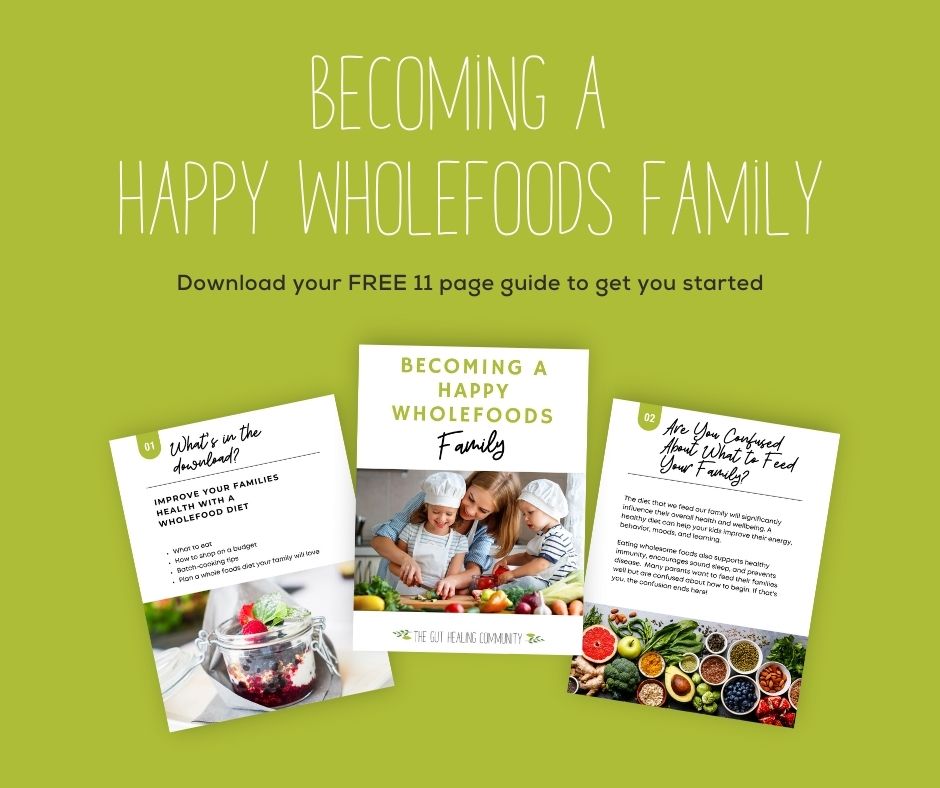In an ideal world we would be eating all fresh organic foods for optimal health and avoiding packaged and processed foods. However, this isn’t always possible and understanding how to read food labels can help you to make informed choices for yourself and your family.
For instance, many ingredients that are added to foods these days have adverse health effects. How do you know what to avoid and what to look for? It can be confusing to decipher food labels. You’re not alone.
We’re going to look at what to look for on labels and things to reduce or avoid.
Firstly, Food manufacturers and marketing companies design their packages to appeal to you. Yet, this doesn’t always mean they are healthy for you. By using these guidelines, you can make better food choices for both yourself and your family.
Skip the claims on the front
The people who design food packages will use the front label to entice you. You’ll often find health claims like no added sugar, low fat, gluten free, keto, paleo.
But often these claims can be deceiving. Often based on a serving size that is smaller than the average person would eat. It might be used to distract from the less healthy features – for example: low fat, but also be full of sugar.
Instead of looking at the front of the package, focus on the information on the back.
Check the order of the ingredient list
On a food label the ingredients must be listed in descending order. This means that:
- the first ingredient listed contributed the largest amount
- the last ingredient listed contributed the least.
When looking at the ingredients lists, if possible you want the first 2-3 ingredients to be wholefoods, rather than numbers. In addition, you want avoid things like sugar or syrup in those first few ingredients.
Minimise additives
Food additives are chemicals added to foods. They are added:
- To Maintain or Improve Safety and Freshness.
- To Improve or Maintain Nutritional Value.
- Improve Taste, Texture and Appearance.
They may include food colourings, flavour enhancers, emulsifiers, sweeteners or a range of preservatives. Therefore, the more processed a food is, the more additives it’s likely to have.
Below is a list of some of the most common additives, what foods they are in as well as the adverse health benefits.
Artificial colourings:
Artificial colourings are chemical based dyes that are used to colour food and drinks. For instance, to make them more appealing.
Some of the particular ones to look out for are:
Yellow No. 5 – Tartrazine. 102. A lemon-yellow dye found in candy, soft drinks, chips, popcorn and cereals. May have an adverse effect on activity and attention in children. Cancer. Therefore, banned in UK, EU, previously banned in Norway. Permitted in Australia.
Yellow No 6 – Sunset Yellow. 110. An orange-yellow dye that is used in candy, sauces, baked goods and preserved fruits. May increase tumour number sin lab animals. May cause chromosomal damage. Therefore, banned in the UK, EU previously banned in Norway. Permitted in Australia.
Red dye No. 2 – Used to colour foods crimson colour. May be carcinogenic. Therefore, banned in many countries. Permitted in Australia.
Red Dye No 3 – Erythrosine. 127. A cherry-red colouring used in candy, ice blocks and cake decorating gels. May cause thyroid cancer and chromosomal damage in lab animals. Therefore, previously banned in Norway. Permitted in Australia.
Red Dye No 40 – Allura Red.129. A dark red dye that is used in sports drinks, candy, condiments and cereals. One of the widely used food dyes, as well as one of the most controversial.
The dye may be linked to allergies, migraine, and mental disorders in children. Red Dye 40 has been linked to aggression and mental disorders like attention deficit hyperactive disorder (ADHD) in children. Therefore, banned in the UK, EU, previously banned in Norway. Permitted in Australia.
Blue #1 – Brilliant Blue. 133. A greenish-blue dye added to candy, ice-cream, canned peas, packaged soups, ice blocks and icings. Carcinogenic, thyroid, may cause chromosomal damage and interfere with brain-nerve transmission. Therefore, previously banned in Norway, permitted in Australia.
Blue #2 – Indigo Carmine. 132. A royal blue dye found in candy, ice cream, cereal and snacks. May cause chromosomal damage. Therefore, previously banned in Norway, permitted in Australia.
Green No 3 – Fast Green. 143. Tinned green peas and other vegetables, jellies, sauces, fish, dessert and dry bakery mixes. May be tumorigenic. Therefore, banned in the UK, EU, previously banned in Norway. Permitted in Australia.
Sweeteners:
High Fructose Corn Syrup
High fructose corn syrup (HFCS) is a sweetener derived from corn syrup. It’s used to sweeten processed foods and soft drinks. Canned fruits, desserts, yogurts, baked goods, cereals and condiments.
From a health perspective, it may contribute unwanted calories that are linked to health problems, such as weight gain, type 2 diabetes, metabolic syndrome and high triglyceride levels. All of these increase the risk of heart disease. Sugar is also inflammatory, can upset the gut microbiome. This may present as a variety of symptoms. Some of the ways in children are: https://theguthealingcommunity.com/7-signs-of-poor-gut-health-in-kids/
Aspartame
Aspartame is an artificial sweetener 200 times sweeter than sugar. Commonly used as a sugar substitute in diet or sugar free drinks and lollies, desserts, sugar free gums, drink mixes, baking goods, cereal, breath mints and chewable vitamins. Linked to cancer, cardiovascular disease, Alzheimer’s disease, seizures, stroke and dementia. Imbalance of gut bacteria mood disorders, headaches and migraines have also been reported.
Additives:
Potassium Bromate used to strengthen the dough and to allow higher rising. May be carcinogenic.
Monosodium Glutamate (MSG). E621. Is created by a naturally occurring chemical called glutamate. Glutamate is tasteless but has the ability to enhance flavour. Often used in Chinese food, canned foods and processed meats. May cause flushing, headaches, sweating, facial pressure, numbness, tingling, rapid heart rate, chest pain, asthma, headaches and even brain damage.
Preservatives:
Sodium Benzoate – Often added to acidic foods such as sauces, jams and saukerkraut. Some concerns around hyperactivity in children.
Sodium Nitrate – Usually used in processed meats, bacon, sausages, cured meats and canned meats. Some concerns that too much may cause pancreatic cancer.
Sodium Sulfite (E221) – Used in wine making. Possible link between asthma and sulfites. Those sensitive to sulfites may present with headaches, breathing difficulties and rashes.
Sulfur Dioxide (E220) – Used in beer, soft drinks, dried fruit, juices, cordials, wine, vinegar and potato products. In those with asthma, may cause bronchial problems, low blood pressure, flushing, tingling or anaphylactic shock.
Propyl Paraben – Often used in bread products, dairy, meat and vegetables. Possibly endocrine disrupting with an effect on sperm counts and testosterone. May alter gene expression.
BHA and BHT (E320) – Found in cereals, chewing gum, potato chips and vegetable oils. Brain altering, affects behaviour and a potential carcinogenic.
If in doubt, aim for 5 ingredients or less
If choosing foods that are packaged, an easy rule of thumb to apply is choose only those that have 5 ingredients or less. Foods that have dozens of ingredients are usually highly processed, making them less than ideal.
There are a few exceptions to the rule, but if you follow it at least 80% of the time, you’ll minimise your intake of additives and other nasties.
Figure out the percentage
Want an easy way to figure out the percentage of macronutrients? This is where the nutritional panel can come in handy.
Go to the per 100g or per 100ml column. This will tell you the percentage of each nutrient. So, if it’s 20g of sugar per 100g, it’s 20% sugar!
Stay Informed
The Chemical Maze
Knowing where to turn for educated information about additives can be confusing. The Chemical Maze is a fantastic resource. Available as both a book and a mobile app. This handy tool is for understanding additives and ingredients in foods. In addition, number abbreviations, other names of additives, what foods they are found in and potential health concerns.
By using this resource comes it allows you to be more informed around what is right for you and your family.
The author Bill Statham says ‘he created the Chemical Maze to make it simpler and easier for people to recognise additives and ingredients in foods and cosmetics that may have the potential to cause discomfort and ill-health. With this recognition comes freedom of choice and for many a new lease on life.’
Originally only available in book form this resource has also been developed into a smart phone app.
Above all, it allows easy browsing through additives, ingredients by name or number, sort by risk level or filter by symptoms and ailments.
Both the book and mobile app are a great resource to use to become aware of potential health risks associated with additives in foods as well as a handy tool to have on the go when doing the shopping. Some people keep a copy in their shopping bag and now with the use of the mobile app can be easily used on the go too. To read more: The Chemical Maze.
In conclusion, understanding how to read food labels and the impact that they may cause on yourself as well as your family you can make better choices towards your health.
Disclaimer:
All content and media on The Gut Healing Community Website is created and published online for informational purposes only. It is not intended to be a substitute for professional medical advice and should not be relied on as health or personal advice.
Always seek the guidance of your doctor or other qualified health professional with any questions you may have regarding your health or a medical condition. Never disregard the advice of a medical professional, or delay in seeking it because of something you have read on this Website.



